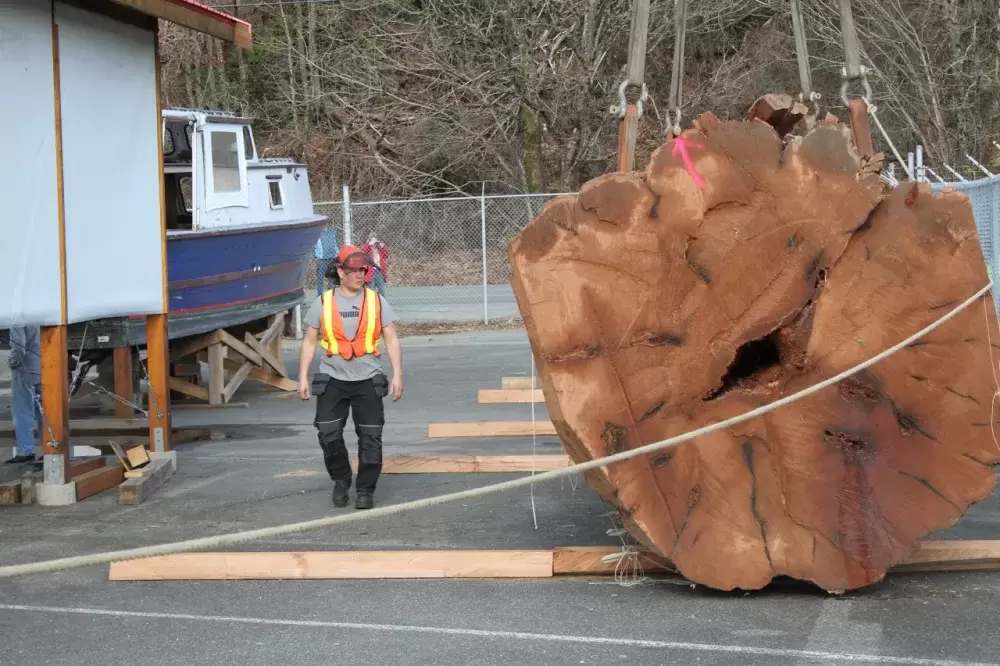A major snag has been hit in the quest to raise a Language Revitalization Pole at the University of Victoria this fall.
Funding for the $400,000 project has completely dried up after about $140,000 worth of work has been completed.
And now officials can only patiently wait and hope additional funds come in so that work can continue and that the pole can indeed be raised in 2019, which is the U.N. Year of Indigenous Languages.
The First Nations Education Foundation (FNEF) had been commissioned to raise funds for the project. That included bringing aboard renowned Hesquiaht First Nation carver Tim Paul to design and help carve the pole.
FNEF Executive Director Scott Jeary estimates about half of the necessary carving work on the pole has been finished. Carving began this past March.
But the next hurdle which has to be completed – and cannot proceed with more funds – is some structural engineering testing at the University of Victoria, at the proposed location of the pole.
“The structural engineering needs to occur in the summer months,” Jeary said. “It kind of needs to be done now.”
Though all money raised thus far has been used up, Jeary said work on the totem pole, which is taking place on the Port Alberni waterfront, has not completely stalled. Carvers are still working on it, just at a slower pace and when they have time to do so.
“The group working on it are doing it out of the goodness of their heart,” Jeary said.
Jeary added it was his foundation’s decision to commence work on the project even though all funding was not set. After speaking to government officials at various levels, he was convinced this was a project that would be well supported.
But government funding has not transpired yet.
“We all knew that all the funds were not in place when the carving began,” Jeary said. “We also knew that if carving did not begin when it did we would not be able to meet the deadline and at the same time, media attention around the carving of the pole could help a great deal in raising those funds.”
Awareness of the pole has been generated in part by a film documenting work being done.
“The film we have created around the process is excellent and it has contributed to getting our message out there,” Jeary said.
Jeary added the FNEF is shouldering any blame for the fact full funding for the pole has not been met.
“Funding is a collaborative effort but it was my organization’s primary responsibility to get those funds in place and the fact of the matter is it has not kept pace with operational requirements,” he said. “We take the role seriously and I do very personally accept that responsibility to push the message forward and realize the funding required to complete.”
Last month Scott Fraser, the Minister of Indigenous Relations and Reconciliation, said his government was committed to true and lasting reconciliation with Indigenous people.
Fraser said the B.C. government invested $2.8 million to support First Nations language revitalization in Nuu-chah-nulth territory from 2018-20.
“Given the current state of Indigenous languages in B.C., it is critical that funding be strategic and focused on programs that foster fluent speakers,” Fraser said. “We will continue to focus our funding on language programs that have strong outcomes for communities and people through established best practices in language revitalization.”
Fraser added government officials have had numerous discussions with FNEF officials to discuss various programs to help get their pole funded.
Jeary said the FNEF is awaiting word from two major funding programs it has applied for. If funding does materialize from either of those sources soon, Jeary said the entire project would be able to be completed on time.
Paul was not caught off guard when funding for the project dried up.
“You always have hiccups when you’re looking for any sort of funding or donations,” he reasoned. “You deal with things as they roll in or as they don’t roll in.”
Paul added though funding has yet to be finalized, it is vital to continue work now on the pole, which symbolizes the importance of language and cultural teachings for Indigenous people.
“The most important thing for us is to go ahead,” he said. “My area is working on this pole. The area for other people is to get the funding.”
Jeary is holding out hope government funding is forthcoming.
“I’d be very frustrated if we don’t get it up this year,” he added. “The pole will get finished. I don’t have any doubt about that. Having it completed this year though is very important.”







